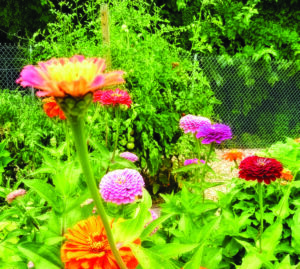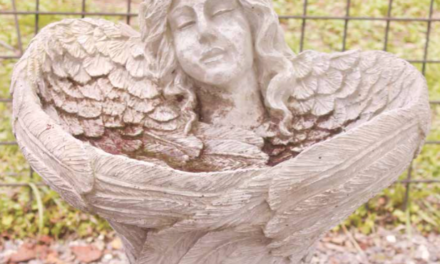
Zinnias at the Waugh Community Garden in Cambridge boast beautiful color while standing tall against dry weather. (Photo by Mike Driscoll)
If the dog days of summer have decimated those once lush flowers, take heart, and take note to shore up and prep ahead for a late summer garden way less likely to wilt, even as the thermometer skyrockets, while maintaining plenty of eye and pollinator appeal.
Horticulturalist and author Barbara Ellis and flower farmer Carrie Lee Jennings shared what’s worked best in each of their backyards with other mid-shore gardeners hoping to botanically beat the late summer heat.
Carrie Ann Jennings, owner of Honeybee Flower Farm in Cordova, offers cottage and wildflower bouquets and buckets for sale at the Easton Farmers’ Market and furnishes floral accoutrements during wedding season, keeping close tabs on how her plants do from year to year.
She recommends a number of annuals able to go without consistent watering or irrigation through late summer and fall.
However, all of them do need healthy watering when initially planted, she stressed.
“Even drought tolerant plants native to the Southwest need consistent water until roots are established,” she advised.
Sunflowers and marigolds are two of the more familiar names topping her list.
Cosmos is typically found in wildflower seed mixtures, “so you know it does well without a consistent watering schedule,” she noted. (During Easton’s annual Plein Air festival, Jennings hosted painters at Honeybee which paid off for one of the artists, who sold a sunflower picture!)
Less mainstream but among her favorite flowers to grow are celosia, also called cocks comb, and gomphrena, also called globe amaranth.
As for perennials, Jennings has grown Verbena bonariensis in a bed without drip irrigation and reports it “returns year after year without supplemental watering, reseeding, but not aggressively.”
Rudbeckia Henry Eilers, while it “looks a bit sad without watering” is another, which reliably mounts an annual comeback despite being sown in a non-drip irrigated bed.
It’s not available by seed, but as a transplant from nursery or garden center, Jennings advised.
If you’re tempted to try growing Tansy, or golden buttons, Jennings warned that, “while beautiful it can become almost invasive in the garden if not cut back before forming seed.”
Ellis, author of “Chesapeake Gardening and Landscaping: The Essential Green Guide,” blogs from her Hackney Point homestead near Chestertown, who has provided her own sustainable gardening insights via workshops and other venues, suggests starting with native perennials such as eastern purple coneflower (Echinacea purpurea) and orange coneflower (Rudbeckia fulgida). (Fun fact No. 2: another coneflower variety, Rudbeckia hirta, is the black-eyed susan, Maryland’s state flower since 1918.) Coreopsis, or tickseed, is another of the tough native perennials that withstand the rigors of the latter half of the season.
The nonnatives reblooming daylilies are another hardy perennial tolerating heat and humidity.
Two of her favorites are the golden Stella d’oro and the brighter, buttery-yellow Happy returns.
Rabbit and deer resistant, they require watering during dry spells.
Among heat loving, long blooming, drought tolerant annuals, Ellis likes zinnia, marigold, and especially sunflower (Helianthus, also in the Asteraceae, or daily/aster family along with Rudbeckia).
But for a wider array of hardy plants providing color long into late summer, she suggests focusing on foliage as well as flowers.
“My mom always had a shade garden that was lush and cool, and heat tolerant,” Ellis recalled, recommending several ferns, with Christmas fern being notably drought resistant.
Hostas, too, are eye catching, and ornamental grasses are definitely worth a look, she added.
Another idea Ellis recommends for additional options to enhance the late summer garden is to “go to fall.”
This year she planted for the first time fall blooming Veronia lettermannii iron butterfly, a.k.a. ironweed. She’s also a fan of striking Autumn fire stonecrop and the low sitting but showy when blooming Sedum sieboldii.
Both are also great pollinators, she noted.
As the temperatures rise, Ellis suggested keeping an eye out for what’s looking good in neighbors’ gardens and at nurseries and garden centers and ask them about what works.
Like Jennings, Ellis believes that to bolster the late summer garden first pay close attention to soil preparation and mulch application, both of which are vital aids in retaining moisture.
The more cover there is, including dead leaves, the cooler the plants tend to stay.
And if well monitored, soil is a great carbon storer, helping promote a more organic environment for helpful insect organisms, she noted.
A mulch made from well-rotted tree trimmer chips works for her.
For bagged mulch, Ellis advises avoiding dyed products which may contain harmful additives.
Whatever you use, aim for a well shredded and “chunky” blanket of coverage, she added.




